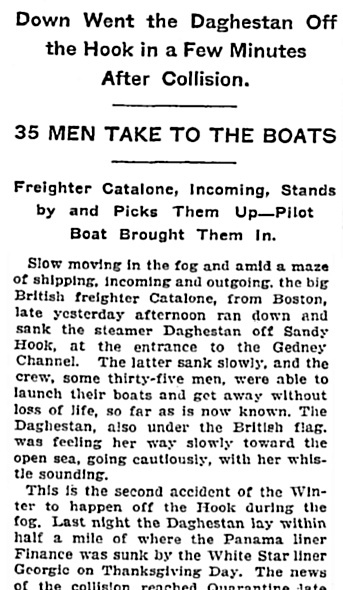Daghestan
- Type:
- shipwreck, freighter, England
- Name:
- Daghestan is a region in southern Russia, adjoining Chechnya and the Caspian Sea.
- Built:
- 1900, England
- Specs:
- ( 353 x 45 ft ) 3466 gross tons, 28 crew
- Sunk:
- Friday December 18, 1908
collision with freighter Catalone - no casualties - Depth:
- 70 ft
This wreck was named "Evergreen" for the large amount of green brass artifacts once recovered from it. The Daghestan was thoroughly demolished since it lay directly in the shipping lane and was a great danger to navigation.

The wreck consists of a very large field of jumbled low-lying debris, hardly anything more than 3-4 ft tall. Even the boiler seems to have been destroyed, and I never found an engine; perhaps it was salvaged. The bottom here is not as silty as most places in this vicinity, but the current can be very strong, so this wreck must be dived with the tide.
Strumming propellers on passing cargo ships overhead make for an interesting experience. Diligent searching by six divers produced only one small lobster and a few nondescript bottles. This wreck is also known as "Stu's" and "The Steamship."
from AWOIS: 1619
FE101/51(F.E. NO. 10, 1951) -- CS-326; ITEM 85 OF SUPPLEMENTAL INSTRUCTIONS FOR PROJECT CS-326, DATED 12 DEC. 1950; WRECK, BELIEVED TO BE DERRICK BARGE B.D. 1738. HUNG AT AN EFFECTIVE DEPTH OF 55.2 FT. CLEARED TO AN EFFECTIVE DEPTH OF 49 FT. CHARTED AS WRECK CLEARED 49 FT. ECHO SOUNDER DEPTH OBTAINED DURING RECON. HYDRO. OF 57 FT. IN 60 TO 63 FT.
H10224/86 -- OPR-C121-WH-86; WRECKAGE WITH 52 FT PNEUMATIC DEPTH GAUGE LEAST DEPTH, WHICH IS BELIEVED TO BE THIS ITEM, APPROXIMATELY 100M SW OF AWOIS POSITION; DIVERS FOUND THE WRECK OF A BARGE, APPROXIMATELY 20 X 45 M; THREE BOILERS AND NUMEROUS OTHER TYPES OF SHIPYARD DEBRIS WERE FOUND STREWN OVER AN AREA OF 360 X 165 FT; IN THE NW CORNER OF THE SITE THE REMAINS OF ANOTHER WRECK WAS FOUND WITH ONLY THE SHELL PLATING AND FLOOR FRAMING REMAINING; APPROXIMATELY 200 FT LONG, 27 FT BEAM AND SHELL PLATING EXTENDING 5 FT ABOVE THE BOTTOM; BOTH ENDS OF THE WRECK TAPERED INTO THE SAND WITH NO BOW OR STERN VISIBLE; ONE OBJECT CONSISTING OF GUARD RAIL TYPE METAL, APPROXIMATELY 2 FT WIDE, 3/8 INCH THICK, AND 40 FT LONG, FORMING A 60 DEGREE ARCH WITH THE MIDDLE STANDING 10 FT OFF THE BOTTOM; SITE CONSISTED OF TWO WRECKS AND SHIPYARD DEBRIS, INCLUDING A BOOM CRANE; LEAST DEPTH TAKEN ON THE TOP OF THE BOILER LOCATED AT THE NORTHEAST SECTION OF SITE. (UPDATED MSD 4/91)
24 NO. 562; BARGE, SUNK 1946 BY MARINE CASUALTY; POS. ACCURACY WITHIN 1 MILE; WD CLEARANCE TO 50 FEET. (SOURCE UNKNOWN).
The wreck to the northwest is the Daghestan; the other is the derrick barge B.D. 1738.

Questions or Inquiries?
Just want to say Hello? Sign the .